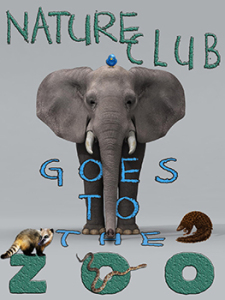 Already hot by 8am in West Java, but our Nature Club kids were keen to get their much anticipated day off and running; today had been organised well in advance and so, must have seemed like an eternity for them. We eventually packed our adventurous Nature Club crew along with, some mum helpers and, of course LFP’s volunteers and trackers into two tray trucks and headed on our way to Garut Zoo to learn more about our focus for this month – endangered species.
Already hot by 8am in West Java, but our Nature Club kids were keen to get their much anticipated day off and running; today had been organised well in advance and so, must have seemed like an eternity for them. We eventually packed our adventurous Nature Club crew along with, some mum helpers and, of course LFP’s volunteers and trackers into two tray trucks and headed on our way to Garut Zoo to learn more about our focus for this month – endangered species.
Most of the wildlife to be encountered here in our little village and surrounding areas is nocturnal, and as the children (and the majority of adults) are too scared to venture into the forest at night,
we decided the next best thing would be to experience the local zoo. ‘Local’ or ‘nearby’ in Indonesia means a 2 hours drive on amostly stoned and unsealed road. The kids being kids loved the trip as they screamed with laughter each time there was a new big bump that would send them flying up into the air. 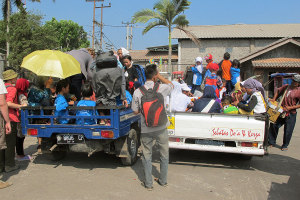 Our volunteers however, were not so amused. I was fine; I sat in the front, as I suffer greatly from travel-sickness! The road trip from our village to the zoo was long and hot and yes, a few children were eventually quite ill from the bumpy and windy roads, but they quickly recovered when they saw the zoo entry.
Our volunteers however, were not so amused. I was fine; I sat in the front, as I suffer greatly from travel-sickness! The road trip from our village to the zoo was long and hot and yes, a few children were eventually quite ill from the bumpy and windy roads, but they quickly recovered when they saw the zoo entry.
A quick head count; name tags on; an explanation of their planned tasks and it would be teams of six including an adult that would venture into all corners of the large zoo. Katy, our student volunteer and superstar (who has a new found passion for education) and I had pre-prepared specific activities for the children to complete during their visit which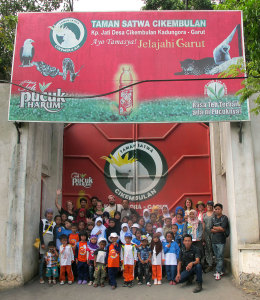 included; describing the animal’s habitats; noting any diets that were detailed on interpretative boards, or that could be found out by asking any of the zoo staff; and most importantly for this exercise whether they animals are a common, threatened or endangered species. We offered the smaller children a ‘picture animal trail’ sheet so as they could include more visual attributes of the observed animal such as; stripes, scales, webbed feet, large beaks etc. With the older children, we offered a more in-depth ‘seek and record’ sheet that would require them to take more of an interest in what they were looking at.
included; describing the animal’s habitats; noting any diets that were detailed on interpretative boards, or that could be found out by asking any of the zoo staff; and most importantly for this exercise whether they animals are a common, threatened or endangered species. We offered the smaller children a ‘picture animal trail’ sheet so as they could include more visual attributes of the observed animal such as; stripes, scales, webbed feet, large beaks etc. With the older children, we offered a more in-depth ‘seek and record’ sheet that would require them to take more of an interest in what they were looking at.
The zoo was host to a number of wild cats and like many zoos around the world, birds played a significant role in the visitor’s viewing experience. There were also several species of primates from Asia represented. The zoo did not have slow lorises, but considering all of the children share their village home with lorises and being involved with LFP’s education programs; they are of course extremely familiar with the species.
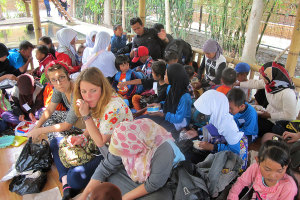 Indonesian children are rather competitive when it comes to this kind of ‘search for clues’ exercise and enjoy trying to find more than each other and as much information as possible. My team (not being biased or anything) would ask zoo staff for directions to the next animal or show the pictures to the keepers asking them for any extra information on the animals to maybe give them the edge they needed to win. Was this cheating? No of course not, this was being creative and incredibly enterprising for such young Nature Clubbers. It was in the end, a great way to save their little legs and valuable time that would be used to get back first to our lunch at the gazebo! We didn’t manage to arrive first unfortunately, but we did come in second place which was a great effort from our team.
Indonesian children are rather competitive when it comes to this kind of ‘search for clues’ exercise and enjoy trying to find more than each other and as much information as possible. My team (not being biased or anything) would ask zoo staff for directions to the next animal or show the pictures to the keepers asking them for any extra information on the animals to maybe give them the edge they needed to win. Was this cheating? No of course not, this was being creative and incredibly enterprising for such young Nature Clubbers. It was in the end, a great way to save their little legs and valuable time that would be used to get back first to our lunch at the gazebo! We didn’t manage to arrive first unfortunately, but we did come in second place which was a great effort from our team.
I will be very interested to see how the children interpret the incredibly important subject of animal decline throughout endangered species month at Nature Club. Coming into this activity the children were asked to name an endangered species, in which only two animals were recognised; the Javan Slow Loris (go figure!) and the iconic and well publicised orangutan.
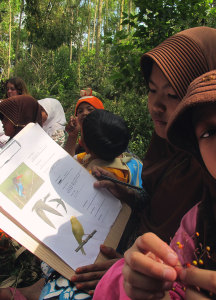 So far our Nature Club ‘themed months’ have proven extremely successful. With every theme, I organise a pre and post questionnaire for the children who are old enough to read and write, which includes a mix of drawing and writing answers required. With each theme that is completed great improvement with knowledge and awareness has been demonstrated, which in turn tells us that learning here is much more effective when done in a fun and ‘hands on’ way.
So far our Nature Club ‘themed months’ have proven extremely successful. With every theme, I organise a pre and post questionnaire for the children who are old enough to read and write, which includes a mix of drawing and writing answers required. With each theme that is completed great improvement with knowledge and awareness has been demonstrated, which in turn tells us that learning here is much more effective when done in a fun and ‘hands on’ way.
Our new ‘secret’ Nature Club House that is currently being built in the new Muslim school means the children will have their own wonderful space to be creative, learn and explore. Environmental Education here will continue to grow and I am so glad to be a part of it.
Sharon Williams – LFP Field Station Coordinator/Environmental Education Officer
